
Worm
Oxygen Sensor May Hold Key to Human Heart Disease
OPA Spotlight on Safety
Teamwork
Worm Oxygen Sensor May Hold Key to Human Heart Disease
BY LYNN YARRIS
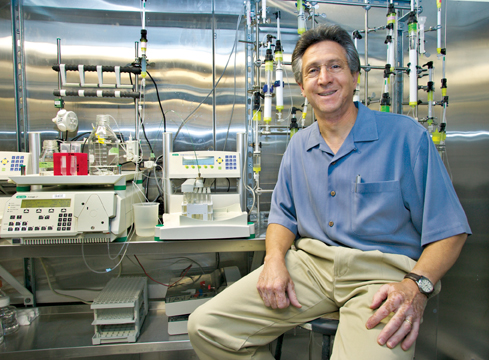 |
|
| Michael Marletta, one of the co-authors of the Nature paper, is a chemist with the Physical Biosciences Division and an Aldo DeBenedictis Distinguished Professor of Chemistry at UC Berkeley. | |
For life on our planet the rule is simple: if you don’t get the right amount of oxygen, you die. For humans, living as we do in an atmosphere with a rich and stable supply of oxygen, maintaining the correct levels in our bodies is a relatively routine task. For organisms that live in soil or water, however, where oxygen levels can fluctuate wildly, the task is far more challenging and has been pretty much of a mystery — until now.
A multi-institutional collaboration of researchers that includes a chemist with Berkeley Lab’s Physical Biosciences Division (PBD) has learned how one soil dweller, the nematode Caenorhabditis elegans, is able to sense oxygen levels in its environment and feed in areas where the concentration of oxygen is just right.
“It’s surprising that more than 200 years after the discovery of oxygen, we’re still finding out how organisms sense and use it,” says Michael Marletta, who holds a joint appointment with PBD and UC Berkeley.
Marletta is one of the co-authors of a paper which appeared in the July 15, 2004 issue of Nature. The other co-authors are Cornelia Bargmann, who holds a joint appointment with the UC San Francisco and the Howard Hughes Medical Institute, plus David Karow of UC Berkeley, Jesse Gray, Hang Lu and Andy Chang of UCSF, Jennifer Chang of the University of Michigan, and Ronald Ellis of the University of Medicine and Dentistry of New Jersey.
The discovery of the oxygen-sensing mechanism in nematodes began as an investigation into a human enzyme, guanylate cyclase, which performs signaling interactions with nitric oxide molecules, which are critical to regulating blood pressure. When nitric oxide enters a human cell, it activates guanylate cyclase, which catalyzes a protein that relaxes and dilates blood vessels. Nitric oxide also plays a prominent role in the brain as well as in the immune system, where it is used as a cell-killing agent.
“When we took apart the guanylate cyclase protein to study nitric-oxide signaling, we found that the binding site is a heme molecule almost identical to the heme molecule that gives hemoglobin its red color and binds to oxygen,” says Marletta. “However, whereas the heme molecule in hemoglobin cannot discriminate between oxygen and nitric oxide, the heme molecule in guanylate cyclase only binds with nitric oxide. Somehow, nature engineered a way for the guanylate cyclase to screen out the oxygen.”
To understand how this screening out of oxygen was accomplished, Marletta and his colleagues cloned the genes that code for the heme-binding site of the guanylate cyclase and searched the genome databases for homologues in other organisms. A similar guanylate cyclase enzyme was discovered in Caenorhabditis elegans, the tiny primitive worm that has become a staple of biological investigations. However, when the researchers ran tests to study the ability of the nematode’s guanylate cyclase, called GCY-35, to bind with nitric oxide, the results were confusing.
“We found no evidence that the GCY-35 enzyme was binding to the nitric oxide,” says Marletta. “However, we were able to isolate the enzyme’s location in sensory neurons that are involved in communication with the outside world.”
At the time, Marletta and his group were carrying out parallel studies with UCSF’s Bargmann, a leading authority on behavioral studies with nematodes. The collaboration hypothesized that the binding of the GCY-35 enzyme to oxygen might be mediating known behavioral responses of C. elegans to changes in the oxygen levels of its environment. To test this hypothesis, a new set of experiments was begun.
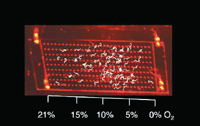 |
|
| As shown here, nematodes in an oxygen gradient avoid both high and low concentrations of oxygen, clustering where the concentration is between six and seven percent. | |
Lu, a postdoc engineer in Barg-mann’s lab, designed a small chamber that could be placed over Petri dishes containing nematodes feeding on bacteria. The chamber allowed the researchers to create precisely controlled gradients of oxygen, which — for this study — ranged from 0 to 21 percent, the concentration of oxygen in ambient air.
Systematic genetic engineering and molecular studies confirmed that the GCY-35 enzyme was binding to oxygen rather than nitric oxide. However, this discovery led to another surprise. It was presumed that the nematodes would prefer the 21-percent oxygen levels, the condition under which laboratory nematodes are routinely kept; but the worms actually much preferred oxygen concentrations of only about 6 to 7 percent. This preference for a lower concentration of oxygen led to an explanation of aggregate behavior, long observed in laboratory nematodes, called “bordering and clumping,” in which large numbers of the worms gather around the border of a Petri dish.
“Bordering and clumping turns out to be a laboratory artifact,” says Marletta. “The bacteria that the worms feed on concentrate at those borders. Since the bacteria are also consuming oxygen, the combination of bacteria and worms lowers the oxygen concentration in the immediate environment. We found that when we reduced the oxygen concentration in a Petri dish to 6 percent, the worms dispersed in three minutes.”
Marletta and Bargmann speculate that the preference of the nematodes for lower oxygen concentrations might be a protective response against levels of oxygen that would be harmful to them. This same mechanism should also be present in fish and other animals that live in environments where the oxygen levels fluctuate. It may also be similar to the mechanism by which the human body deals with hypoxia (oxygen deficiency).
Marletta and his research team have already begun structural chemistry studies that they believe will enable them to predict whether a given guanylate- cyclase enzyme will be an oxygen or a nitric oxide sensor. A better understanding of how these enzymes are able to selectively bind to nitric oxide or oxygen will have implications across a wide swatch of biology, including research into human cardiovascular diseases.
OPA Spotlight on Safety Teamwork
BY MONICA FRIEDLANDER
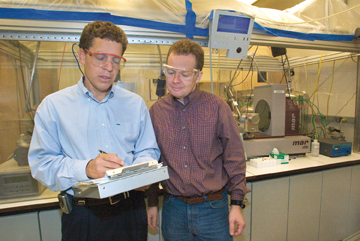 |
|
| Jack Salazar (left) and Jeff Pelton | |
To get an inkling of the herculean tasks facing Jeff Pelton and Jack Salazar on a daily basis, consider this: among the many hats they wear at Berkeley Lab, Pelton, the safety coordinator for the Physical Biosciences Division (PBD), and Salazar, the EH&S liaison to PBD, oversee the safety of a division whose 300-plus staff is scattered over 14 buildings on the Hill, on campus, and in downtown Berkeley. Add to this communication and coordination challenge the need to integrate and reconcile two different safety systems and sets of regulations — those of the University of California and of Berkeley Lab, which has jurisdiction over the work performed at Calvin Lab on campus, where much of the PBD work is conducted. Moreover, the building presents many unique safety challenges of its own. Enough to raise anyone’s blood pressure, right?
Wrong, if you ask Pelton and Salazar, who were recently honored with an Outstanding Performance Award (OPA) for their exceptional teamwork, which mitigated safety concerns at Calvin Lab. In fact, neither of them could understand what the fuss was all about.
“It’s nice, we won’t turn down the award,” laughs Salazar. “But it’s just part of what we do.”
The OPAs, however, are not just handed out for every good deed. Synonymous with excellence at Berkeley Lab, the award is given out three times a year to the Lab’s best and brightest for “exceptional, outstanding efforts that surpass defined goals and expectations.” Honored thus are both individuals and teams, sometimes combining cross-divisional efforts, as is the case with Pelton and Salazar.
“Team science, teamwork. These are the foundation of what makes Berkeley Lab a great place to do science and a great place to work,” says Sally Benson, the Lab’s deputy director for Operations. “Outstanding Performance Awards are one of the most important ways in which we can demonstrate our recognition of the tremendous contributions of so many people here at the Laboratory.”
What makes Pelton and Salazar’s work so successful is the twosome’s no-nonsense approach to safety. Their goal is not merely to enforce regulations for their own sake, but to do it in a way that promotes the work and science at the Lab.
“We’re advocating for research-ers,” says Pelton, a PBD scientist himself. “We don’t try to find problems, we try to find solutions.”
This theme defines their entire approach to safety at Berkeley Lab. Although much of their work, by its very nature, is conducted in a bureaucratic environment, Pelton and Salazar look at challenges from the scientist, or client’s perspective.
“If you come up with things that are overburdensome or that don’t make sense, just steeped in rules and regulations, you may win a battle here and there but overall you won’t make things a lot better,” Salazar says. “Scientists understand that Jeff is a researcher and that we don’t come with draconian-type fixes. We work with the researchers.”
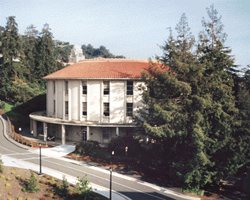 |
|
| Jeff Pelton and Jack Salazar won their OPA for their work to ensure safety at Calvin Lab on the UC campus. The facility houses much of the Physical Biosciences staff. | |
Pelton has served as safety coordinator since October 2000 in addition to performing his ongoing programmatic research duties. Salazar is PBD’s single point of contact from the EH&S Division. Their effort in the area of safety for PBD involves an enormous range of tasks — everything from investigating accidents to coordinating and conducting training, implementing new programs, conducting inspections, overseeing pre- and post-OSHA inspection work, and — perhaps most important — intervening quickly when something goes wrong.
Excelling in all these areas takes rare dedication, planning, and teamwork.
“The exemplary work they have performed together has been consistently outstanding, and has saved the division, the Laboratory, and the campus from many instances
of risk exposure,” according to the citation for their nomination for the OPA, which was signed by both division heads, Graham Fleming for PBD and Robin Wendt for EH&S.
But Pelton and Salazar are quick to add that it takes more than just their individual efforts to succeed.
“The division management at PBD is extremely supportive of safety,” Salazar says. “I don’t think any of this would be possible if the message wasn’t coming from the division management. We don’t want to be policemen. People are responsive to us because they know Division Director Graham Fleming won’t accept anything less.”
Although humble in accepting the OPA, Pelton and Salazar look
at the award as more than just recognition of their achievement. Says Pelton, “It also promotes safety by recognizing our safety roles and the importance of safety at the Lab.”
To encourage the kind of teamwork and individual excellence exemplified by Salazar and Pelton, managers and supervisors labwide are encouraged to nominate outstanding effort among their employees for OPA awards.
The time to submit nominations for the next OPA cycle is right now. While the final deadline is Aug. 2, supervisors should contract their HR centers as soon as possible, since they each have their own internal deadlines to meet before they submit the nominations to Compensation on Aug. 2.
Nomination forms can be downloaded off the web at http://www. lbl.gov/Workplace/HumanResources/ forms/.
Regents Salute Director Shank as Departure Nears
Director Shank Honored by UC Regents
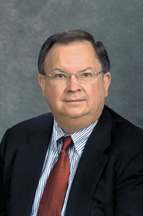 |
|
| Director Charles V. Shank | |
Last week the University of California Board of Regents recognized Berkeley Lab Director Charles V. Shank’s contributions over his 15 years of service by drafting the following resolution, which was read into the record and punctuated with applause.
July 2004
THE REGENTS OF THE UNIVERSITY OF CALIFORNIA IN APPRECIATION OF CHARLES V. SHANK
WHEREAS, The Regents of the University of California wish to commend and thank Charles V. Shank for his outstanding service to the University and the nation as the fifth director of the Lawrence Berkeley National Laboratory, one of the crown jewels of the nation’s scientific effort; and
WHEREAS, he has made an indelible imprint upon the Lawrence Berkeley National Laboratory, meticulously building upon the strong foundation laid down by his predecessors, as well as forging a bold and challenging new blueprint for the Laboratory that has broadened and deepened its scientific mission, thus preserving its historic preeminence in high energy and accelerator physics, as well as firmly establishing it as a leader in nanoscience, genomics, computational research, and astrophysics cosmology; and
WHEREAS, under his dedicated stewardship and clear vision, he has moved the Laboratory resolutely into the 21st century with the highly successful completion of the Advanced Light Source, the siting of the National Energy Research Scientific Computing Center at LBNL, the construction of a new nanoscience research facility known as the Molecular Foundry, the collaboration with LBNL’s sister laboratories on the Joint Genome Institute, and the launching of the Supernova Cosmology Project, a major scientific effort that led to the breakthrough discovery of the mysterious force commonly known as “dark energy”; and
WHEREAS, a renowned scientist with a steadfast commitment to the highest values of intellectual life and to furthering the cause of science, he provided a fertile breeding ground for the Lawrence Berkeley National Laboratory’s most eminent researchers and scientists, which has led the way for groundbreaking advances and discoveries across a wide spectrum of disciplines that have improved the human condition and enhanced the safety and security of the people of this nation and, indeed, the world; and
WHEREAS, an administrator of consummate skill who has made excellence his standard, he has remained steadfast in his great love of science, maintaining a vigorous research program, supervising a team of graduate students, and authoring or co-authoring more than 200 scientific publications;
NOW, THEREFORE, BE IT RESOLVED that the Regents express their deep appreciation to Charles V. Shank for his unparalleled efforts on behalf of the Ernest Orlando Lawrence Berkeley National Laboratory, the University of California, and the nation’s science enterprise, and extend their best wishes as he prepares to return to the Berkeley campus as a distinguished member of the faculty in the departments of physics, chemistry, and electrical engineering;
AND BE IT FURTHER RESOLVED that a suitably inscribed copy of this resolution be presented to Chuck and Heather Shank as a token of the Regents’ high regard and warmest good wishes for a future rich in happiness and continued accomplishment.
Sharing the Hill with Friendly Neighbors
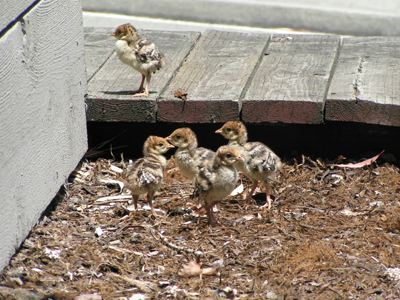 |
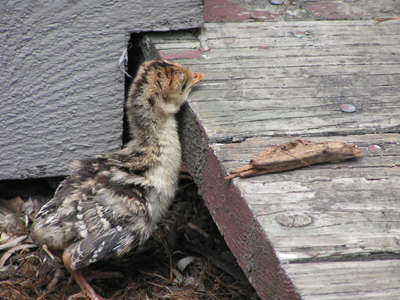 |
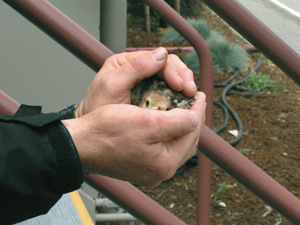
|
 |
 |
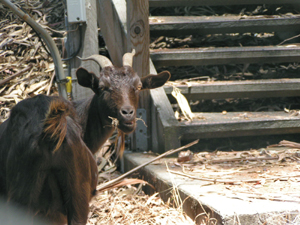 |
Recently, employees in the Bldg. 65 complex, located near Blackberry Gate, helped rescue a gaggle of wild turkey babies who were stuck beneath a nearby stairwell while their mother frantically squawked at them (above). After each baby was helped out of their jam, the mama bird quickly inspected them, then scurried her brood out of the area.
Among the other critters sharing the Lab's hillsides are goats (right) who are brought here every year to provide vegetation management (see story below for more).
Goat-herding Puppy Hits the Ground Running
BY D. LYN HUNTER
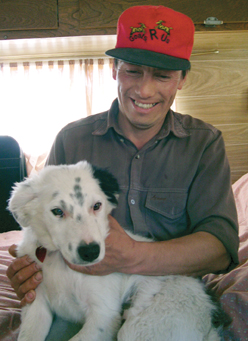 |
|
| Rodrigures with new pal, Nupi | |
The life of a goat herder can be hard and lonely. Just ask Jaime Rodrigures, who by himself watches over the Lab’s 300-plus grass-eating goats. This native of Chile clambers up and down steep hillsides every day in his effort to move the goats to various locations. Needless to say, Rodrigures is one tired man come bedtime.
But help has arrived. He has four legs, is covered in soft, white and black fur, and sports a pair of dark eyes that, when met head on, can melt even the coldest heart.
His name is Nupi, and he’s a lovable Border Collie puppy that arrived here last week. His sole purpose in life seems to be making Rodrigures happy and rounding up goats.
Nupi was delivered by Goats ‘R Us, the firm Berkeley Lab hires to provide vegetation management each year. The seemingly insatiable goats rid the hills of dry weeds and grasses, which helps prevent the spread of fire.
Despite being only four months old, Nupi has literally hit the ground running, says Rodrigures, who was interviewed through a translator. “He is doing really well; learning very quickly,” he says. “His instincts are so strong, it is very easy to train him.”
The most important skill for Nupi to acquire is recognizing the various hand gestures that Rodrigures uses to indicate where the goats should be guided. “He is a very sweet and loving dog,” says Rodrigures. “You can’t discipline him by yelling. It has to be done gently, or he’ll stop working.”
Despite his innate abilities, Nupi is much more than just a working dog. He also provides companionship for Rodrigures, who must remain on the Hill virtually 24/7 to watch over the goats.
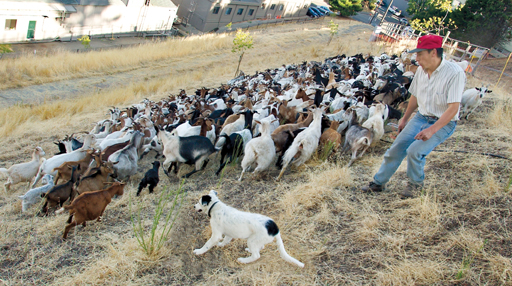 |
|
| Only four months old, Nupi the Border Collie puppy is already helping herd the goats that munch their way up and down the Lab’s hillsides this summer. Photo by Roy Kaltschmidt, TEID | |
Rodrigures lives onsite in a small trailer. In his spare time, he watches Spanish-language programs on a portable TV or listens to the radio. He does all his cooking in the trailer’s tiny kitchen and uses the bathroom in a nearby building.
On a mirror hangs a photo of his wife and two young children, whom he will not see for nearly three years, as he completes his contract with Goats ‘R Us. Nupi helps quell the pangs of homesickness, he says. And the dog has happily assumed much of the goat-herding grunt work that Rodrigures was formerly responsible for.
“The other day, without me giving him any direction at all, Nupi was already out there rounding up some stray goats,” he says proudly. “He has made my job so much easier.”
A special thanks to Alice Ramirez, a graphic designer in the Technical and Electronic Information Department, for providing translation services.
SECUREarth Goes Underground to Meet Growing Energy and Environmental Needs
BY DAN KROTZ
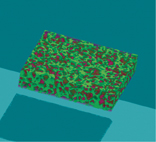 |
|
| Imaging the pore structure of rock, like this analysis conducted at the Advanced Light Source, will help scientists improve oil and gas recovery, environmental remediation, carbon sequestration and nuclear waste disposal. | |
By 2020, one-third of the world’s population may lack access to clean water, air, and affordable energy. That same year, it is estimated that U.S. energy demands will have risen 40 percent from today’s levels, an increase that far outpaces the nation’s energy production capabilities.
“There is no way with current technologies that we can meet these needs,” says Gudmundur “Bo” Bodvarsson, director of Berkeley Lab’s Earth Sciences Division, who, along with Deputy Director Ernie Majer, is one of the architects of an initiative that could help avoid this impending crisis. Berkeley Lab, in collaboration with other national labs, universities and industry, is spearheading this new multi-agency, multidisciplinary initiative.
Called SECUREarth, the program’s mission is to ensure energy security and environmental protection by improving the understanding of how subsurface processes impact water resources, environmental remediation, agriculture, energy production, and climate change.
And because 2020 isn’t far off, SECUREarth will pool the nation’s experts into a single program designed to accelerate the study of these incredibly complex and interrelated issues.
“To meet tomorrow’s demands, we need a quantum leap in our understanding of subsurface processes — and SECUREarth can help us do that,” says Bodvarsson.
A critical step in the program’s development is planned this fall, when as many as one hundred scientists from national labs, government agencies, universities, and industry will convene and draft a detailed science plan that outlines SECUREarth’s research priorities. This report will be a first step in producing a plan that will be reviewed by the National Research Council, a National Academy of Sciences agency that advises the federal government on science and technology issues.
The scientists will focus on two broad problems. The first is how best to clean up and isolate subsurface waste, whether it’s existing waste such as at the Hanford Site in Washington State, or potential waste, such as at the proposed Yucca Mountain nuclear waste repository. They’ll also tackle carbon sequestration, or the long-term underground storage of carbon dioxide, an important greenhouse gas.
The second problem concerns how to most efficiently locate and extract the subsurface resources that drive the economy and influence quality of life. These include oil and gas, geothermal energy such as hot water and steam, and water for agriculture, power plants, and drinking needs.
Although these problems may appear unrelated, they all require the same fundamental research into how fluids and gases behave in porous and fractured rocks. They also require taking phenomena that occurs on the scale of microns, and determining how they affect systems that span tens of square kilometers or more.
“These problems are too complex to be resolved from a single-investigator approach. They require a multidisciplinary, solution-driven team,” says Bodvarsson.
 |
|
For example, to learn how water flows through a contaminated site, Advanced Light Source measurements could determine the properties of the site’s subsurface material at the molecular level. Other scientists could conduct laboratory-based research to determine how fluids move through the porous media. And field tests at different scales could help resolve water flow patterns and the migration of contaminants. In addition, geochemical and microbiological approaches can be developed to manipulate water and contaminant migration through the subsurface rocks. All these data could be used to fine-tune and verify predictive numerical models that portray the water flow and contaminant movement through the site.
“This multidisciplinary approach requires geologists, hydrologists, chemists, microbiologists, numerical modelers computer programmers, theoreticians, and synchrotron experts to work together toward the common solution of very complex problems,” says Bodvarsson. “Only an initiative like SECUREarth can facilitate and expedite this collaborative approach, which is why this initiative is absolutely essential to secure the nation’s energy and environmental future.”
Summer Lectures Series
The Surprising Connection Between Water and Energy
BY PAUL PRUESS
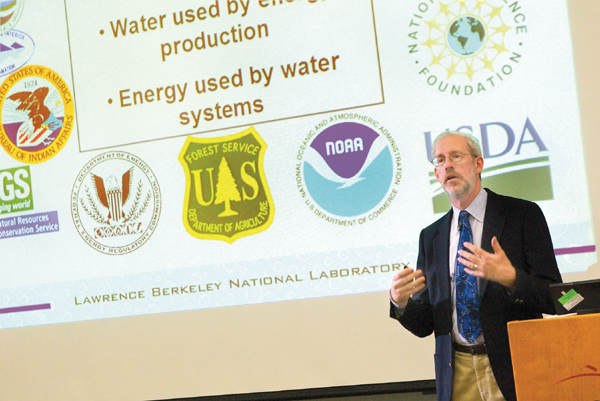 |
|
| Jim McMahon | |
Think that removing salt from seawater can slake the nation’s growing thirst? Once the cost of energy to run desalination plants is figured in, you may not be so optimistic.
The connection between energy and clean water is more intimate than most people realize, said the Environmental Energy Technologies Division’s Jim McMahon in the last of this year’s summer lectures. For example, among the most significant impacts of global warming, chiefly caused by energy use, are likely to be changing patterns of snowfall and rainfall, affecting flooding and the water available to farms and cities.
One statistic that surprised even him at first, McMahon said, was the amount of fresh water needed to cool the nation’s electricity-generating power plants: at 39 percent of the total, power plants use as much fresh water as agriculture.
McMahon also showed that efforts to save energy, like those following the mid-1970s oil crisis, typically reduce and stabilize water use. “A simple example is that a more energy-efficient washing machine also uses less water,” he said. “We at Berkeley Lab believe energy and water must be looked at together.”
McMahon heads the Lab’s Water and Energy Technology Team (WETT), with researchers from EETD, Earth Sciences, and NERSC working together to improve forecasting and information about water supply and quality, invent and market better water and energy-saving technologies, and promote wiser water management policies.
McMahon and his colleagues are already beginning to see results from their efforts. His series-ending summer lecture had to be delayed two days by a quick trip to Washington, during which he participated in the introduction of New Mexico Senator Pete Domenici’s National Laboratory Water Technology Research and Development Act, which would authorize $200 million annually for basic and applied research and development in water supply technologies.
The Spirit of Lawrence’s Lab Lives on at CERN
BY JON BASHOR
 |
|
| Aerial view of CERN, showing the path of Large Hadron Collider tunnel. | |
GENEVA, Switzerland — Six thousand miles east of Berkeley, in the rolling countryside of the Swiss-French border, the spirit of Ernest Lawrence is alive and well. Berkeley Lab’s founder is noted for many contributions to scientific knowledge, but probably most for the invention of the cyclotron and for his idea of bringing together groups of people with a diversity of knowledge and expertise to take on the biggest scientific challenges.
At CERN, the European Organization for Nuclear Research, a precise model of Lawrence’s first cyclotron is part of an extensive display introducing visitors to particle physics research. Unseen by most visitors is a 27-kilometer-long circular tunnel currently being revamped to house the Large Hadron Collider (LHC). When it goes online in 2007, the LHC will smash protons from two beamlines at energy levels never before achieved in laboratory conditions.
These collisions are expected to recreate the conditions found at the earliest time of our universe — one quadrillionth of a second after the Big Bang. A set of experiments has been designed to glean a greater understanding of the universe. Two very large detectors in progress of being built — ATLAS and CMS — will epitomize the Big Science approach favored by Lawrence.
In all, some 1,800 scientists from 150 institutions in 35 countries are working on ATLAS, including a number of scientists from Berkeley Lab. Some of them, like Alessandra Ciocio of Physics, regularly fly to Geneva for a week of intensive meetings. Others, like David Quarrie and Mossimo Marino of NERSC’s High Energy Physics Group, have moved there for extended stays. In February, Quarrie will mark his second year in Geneva as the software project lead for ATLAS — a daunting task involving about 200 people spread around the world.
Both Quarrie and Ciocio greet visitors with a common question: “Would you like to get some coffee?” This is not just a pleasant diversion. It’s an integral way of working. CERN takes its coffee very seriously, whether you order it from the café on the ground floor of the five-story atrium in the center of the ATLAS office building or from the central cafeteria with its self-serve espresso machines.
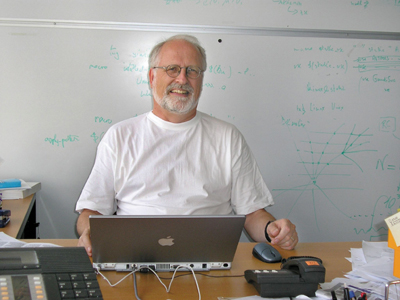 |
|
| Berkeley Lab’s David Quarrie is the software project lead for ATLAS. | |
“On most mornings we have coffee in the common areas. Getting together outside the office is a good venue to talk over issues that people may not want to discuss in a meeting, and this way you can take the time you need to thoroughly discuss an issue before you resolve it,” Quarrie said, sipping a cup of strong coffee on the shaded patio of the cafeteria. “I’ve also found that it’s a low-stress opportunity for people to talk about the things that are really worrying them. Plus, it’s just a good way to get to know people so you feel comfortable working together.”
Ciocio, at CERN the last week of June to attend a series of meetings and present a progress report on her group’s efforts to deliver 550 silicon strip modules to be used in the ATLAS Inner Tracker Detector, says discussions typically continue over dinner and into the late evening. For her, visiting CERN is also something of a homecoming — she has worked here periodically since the 1980s and is greeted with handshakes and kisses on the cheek on arrival. CERN is also where she met her husband, Kevin Einsweiler. As another Lab scientist in Physics who is working on detectors for ATLAS, Einsweiler is also a frequent visitor at CERN.
“I have hundreds of friends here, from the cashiers to the scientists,” Ciocio says, pausing to wave at a passerby. “When I go to pay in the cafeteria, the cashier asks me, `How are your kids? I saw your husband when he was here last week.´”
For Quarrie and his wife Avril, who retired from Berkeley Lab when they moved here in 2003, the transition has included making new friends. Both are avid Scottish dancers and they have joined a group in Geneva. They have bought a house in France and are enjoying walking among the vineyards surrounding CERN.
Like nearby Geneva, CERN has an indigenous international atmosphere. The Swiss-French border cuts across the lab site and conversations can be overheard in many languages, from English to French, German to Japanese, Italian to Spanish. The cafeteria accepts payment in both euros and Swiss francs, and sells French wine and Danish beer. Jets from the nearby airport take off noisily, connecting with the world.
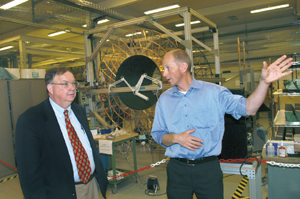 |
|
| Lab Director Charles Shank (left) is pictured during a visit to CERN with Steinar Stapnes of Oslo, Norway. Behind them is the Transition Radiation Tracker being assembled for the Large Hadron Collider. | |
But these global connections come at a price. Keeping in touch with far-flung collaborators often means coming in early and staying late. Ciocio said it’s not unsual for her group to hold simultaneous e-mail exchanges with colleagues in England and Japan. Quarrie said he often rides his bike in at 7:30 a.m. so he can have time to answer e-mails and collect his thoughts before meetings start at 9. Teleconferences with his group back at Berkeley Lab start after dinner and can go until 7:30 or 8 p.m.
“With all the time differences, it makes for a longish working day,” Quarrie said “I can’t remember the last time I worked a 40-hour week.”
Jon Bashor, public affairs officer for Computing Sciences, is on leave this summer, working with communications groups with research organizations in Europe. He filed this dispatch from Switzerland.
ATLAS Reaches Out with Animation
BY PAUL PRUESS
| Animator and physicist João Pequenão photographed a single pixel assembly, then reproduced it many times to construct this detailed view of ATLAS’s innermost detector. | ||
The 1,800-member international ATLAS collaboration recently reelected Michael Barnett of Berkeley Lab’s Physics Division and Erik Johansson of Stockholm University as co-chairs of the ATLAS education and outreach program. ATLAS is the largest of the detectors under construction for the Large Hadron Collider (LHC) at CERN, the European laboratory for particle physics near Geneva, Switzerland.
The powerful proton-proton collider isn’t scheduled to be switched on until 2007, but when that happens, Barnett warns, watch out: “ATLAS will see what it’s going to see very fast.”
Anticipated finds include “sparticles” and other species predicted by supersymmetry theories, plus the much-sought-after Higgs boson, carrier of mass. Barnett says, “Its discovery will be just one of many things we’ll learn, including the completely unexpected.” Stranger possibilities include miniature black holes and extra dimensions of space.
All these novelties must be sorted from a radiation storm of trillions of ordinary particles emanating each second from tens of millions of proton collisions in ATLAS’s heart. To explain the complex experiment, the outreach team’s João Pequenão is on a six-month visit from CERN’s branch office in Portugal to assemble a half-hour animated reconstruction of ATLAS — detailed right down to the innermost detector’s 140 million individual silicon pixels.
Using computer-graphics software like that used to create Hollywood special effects, Pequenão works from detailed engineering drawings and other sources — including photos of pixel-detector components developed here at Berkeley Lab, which he reiterates many times. When the movie is done, he says, the viewer will be able to “fly through the giant detector like a Star Wars spaceship.”
Pequenão has occasionally improved upon the commercial software — “I like to write my own algorithms for some effects” — and he’s composed his own music score as well. The finished movie will include an opening overview, a detailed look at each major component and how it works, and a sampling of collision patterns ATLAS will be looking for in the unceasing particle storm — a characteristic Higgs-boson event, the production of supersymmetry particles, and so on.
In Barnett’s words, “We’re trying to explain what’s difficult to explain” to an audience of all kinds of people, from high school students to government science ministers. Clear explanation is the goal of all the many ATLAS education and outreach projects.
An introductory piece of the animated movie already completed can be viewed (in very low resolution) on the ATLAS experiment website, at http://atlas.ch/.
Jim Bristow on Community Sequencing and Ecogenomics
BY DAVID GILBERT
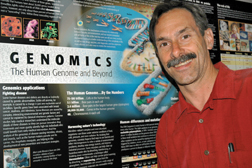 |
|
| Jim Bristow | |
Jim Bristow, the deputy director of Berkeley Lab’s Genome Sciences Division, is acting head of the Biology and Community Support Department at the Joint Genome Institute (JGI). A Harvard-trained M.D., Bristow is a pediatric cardiologist with 15 years of experience in clinical practice (at UC San Francisco) and in laboratory investigation of the molecular genetics of connective tissue disorders and heart development. A collaborator and guest of Berkeley Lab for five years, Bristow joined the JGI in January and has taken over major responsibility for the $20 million Community Sequencing Program, which provides large-scale DNA sequencing support for investigator-initiated projects spanning the range of modern biology — from microbial communities to human variation and disease. At JGI he continues to pursue his interest in human congenital malformations through high-throughput sequencing of candidate genes. This week Bristow shared his views about the future of the genomics program at JGI with the readers of the View.
VIEW: It’s been seven years since the founding of the JGI and five years since the institute united DOE’s sequencing resources and capabilities at Berkeley Lab, Lawrence Livermore and Los Alamos national labs in the Production Genomics Facility in Walnut Creek. With the Human Genome Project behind us, where does JGI go from here?
BRISTOW: JGI was responsible for sequencing 11 percent of the human genome comprised by chromosomes 5, 16 and 19, all published (or soon to be) in the journal Nature. Several of us at JGI have backgrounds in human and mammalian genetics, so we will continue to have a small health related program. For instance, we have ongoing projects to evaluate the function of noncoding sequences conserved across species and to define the genetic contribution to a variety of human diseases. However, we have moved away from a fundamental emphasis on human health and toward a new focus on the health of the environment. This is taking the form of a new ecogenomics initiative.
VIEW: What do you mean by “ecogenomics”?
BRISTOW: We have only recently begun to appreciate how enormously complex the microbial world is. Our previous understanding of microbes comes from the tiny fraction of microbes that have been cultured in the laboratory. Ecogenomics is a new field that seeks to understand microbial communities in the environment through sequencing rather than through cultivation. It is now clear that a preliminary understanding of the microbes living in a specific environment can be gleaned from the sequences of DNA fragments isolated directly from environmental samples. In the simplest cases where only a few microbes are present, the DNA sequences can be assembled into complete genomes for organisms that have never been cultured. In more complex environments, the sequence reveals the presence of specific genes that serve as a fingerprint for the organisms that are there and provides some insight into their metabolic capabilities.
The best example of this is the Iron Mountain acid mine Superfund site. Working with UC Berkeley’s Jill Banfield, JGI investigators sought to understand the microbial community’s contribution to liberating heavy metals and acid from Iron Mountain into the local watershed. By sequencing 75 million basepairs of DNA extracted directly from the biofilm in the mine, the genomes of five organisms were assembled. This provided a new understanding of carbon and nitrogen fixation and energy metabolism in this microbial community, and enabled subsequent culture of a subset of the organisms. The hope is that by understanding the microbial community, potential treatment strategies can be focused on the microbes that are the root cause of the problem, rather than on treatment of the symptoms (run-off of acid and metals) that has been largely unsuccessful.
VIEW: What can you tell us about the organisms that JGI is currently sequencing?
BRISTOW: We are nearing completion of two large and important genomes: the first tree, Populus trichocarpa, a poplar more commonly known as the black cottonwood, and a frog called Xenopus tropicalis. Poplar is the tallest broadleaf hardwood tree in the West, growing to 200 feet tall and to six feet in diameter. Its genome information will aid in our understanding of biomass conversion and help diminish the release of greenhouse gases to the atmosphere. Xenopus is an important “sentinel organism” for the Environmental Protection Agency because it is one of the most sensitive species — first to suffer the effects of environmental degradation.
VIEW: The DOE has made a bold statement by repositioning the JGI as a nontraditional user facility through the launch of the Community Sequencing Program (CSP). Can you tell us how this will work?
BRISTOW: DOE will pick up the tab on large-scale sequencing projects that will open the door for scientists in nonbiomedical fields that have not previously had access to high throughput genomic sequencing — in disciplines such as geology, oceanography and ecology. Proposals submitted to the CSP were evaluated by a group of experts from the scientific community. We accept applications from any researcher interested in generating informative DNA sequence (of at least several million basepairs) from whole organisms or communities of organisms. Successful proposals are driven by scientific excellence that will advance our understanding of the natural world.
VIEW: Can you give us a few hints and highlights of what to expect in terms of collaborations flowing through the CSP?
BRISTOW: JGI’s Scientific Advisory Committee convened last week and gave its blessing to the roster of species and communities that passed muster with our scientific reviewers. Out of 56 proposals, we approved 20. As with all of our projects at JGI, the data generated under CSP-supported projects will be made freely available to the entire scientific community. The advisory committee approved three animals that fill a large gap in the tree of life: a limpet (Lottia), a leech (Helobdella), and a worm (Capitella). We will also be sequencing a fern (Selaginella) and a moss (Physcomitrella). These plants (along with the poplar genome) and the green alga Chlamydomonas solidifies JGI’s position of leadership in plant genomics. All told, CSP sequencing will amount to 14 billion bases or about half of JGI’s 2005 sequencing capacity — nearly five times the size of the human genome.
VIEW: As a scientist, what gets you most excited about this new era that JGI is entering?
BRISTOW: For me personally it’s been exciting to be a part of something as big as JGI. My previous science has been relatively small-scale, and it’s fun to be a facilitator of a broad range of genome projects — from gutless worms and animals that live in hydrothermal vents to the microbes that live under their skin or on their backs. It’s also very exciting to be able to do large-scale experiments in my own field of human malformations.
Berkeley Lab View
Published every two weeks by the Communications Department for the employees and retirees of Berkeley Lab.
Reid Edwards, Public Affairs Department head
Ron Kolb, Communications Department head
EDITOR
Monica Friedlander, 495-2248,
msfriedlander@lbl.gov
Associate EDITOR
Lyn Hunter, 486-4698 lhunter@lbl.gov
STAFF WRITERS
Dan Krotz, 486-4019
Paul Preuss, 486-6249
Lynn Yarris, 486-5375
CONTRIBUTING WRITERS
Jon Bashor, 486-5849
Allan Chen, 486-4210 David Gilbert, 925-296-5643
FLEA MARKET
486-5771, fleamarket@lbl.gov
Design & Illustration
Caitlin Youngquist, 486-4020
TEID Creative Services
Communications Department
MS 65, One Cyclotron Road, Berkeley CA 94720
(510) 486-5771
Fax: (510) 486-6641
Berkeley Lab is managed by the University of California for the U.S. Department of Energy.
Online Version
The full text and photographs of each edition of The View, as well as the Currents archive going back to 1994, are published online on the Berkeley Lab website under “Publications” in the A-Z Index. The site allows users to do searches of past articles.
Flea Market
- AUTOS & SUPPLIES
- ‘90 BMW 735i, 112K mi, silver, auto, leather, sunrf, ac, pwr win & seat, exc cond, $5,900, Eran, (925)-957-1918 (H), (925) 212-7394 (cell)
- HOUSING
- BERKELEY, resid community of scientists and grad students, Hearst Commons, 1146-1160 Hearst, reserved parking, studio townhouses w/ decks, hrdwd flrs, skylights, dw, ac, sec, (415) 505-6500, units from $850, hearst.commons@jps.net for pictures or visit www.live-work.us
- BERKELEY, nr MLK & Dwight Way, fully carpeted house built in 2002, 3 bdrms/1 bth, kitchen, double-pane windows, forced air heating, w/d, deck, nice quiet neighborhood, offstr parking, nr downtown, 1-yr lease, no pets, 1st mo+dep equal to 2 mo rent, avail 8/1, David, 666-1291, david@hammockjunkies.com
- BERKELEY, nr MLK & Dwight Way, fully carpeted 2nd flr apt built in 1989, 3 bdrm/2 bths, 2 fp, big kitchen w/ dw, double-pane windows, forced air heating, w/d, redwood deck, master bdrm has fp, master bath jacuzzi tub, offstr parking, nr downtown, 1-yr lease, no pets, 1st mo rent+dep equal to 2 mo rent, avail 8/1, David, 666-1291
- BERKELEY HILLS, very nice, fully furn, 1 bdrm/1 bth inlaw apt, nr shopping & trans, avail 8/1, spacious liv rm w/ din area, w-w carpet, recently remodeled, priv patio, marble bthrm, cable TV, modern kitchen, $1,090/mo+$50 util, non-smok, Helga, 524-8308, Ivankash@hotmail.com
- KENSINGTON, fully furn 3 bdrm home, view, quiet setting, one cat, avail for vis scientist during fall term (Aug - Jan), flex, $1600/mo + sec deposit, Ruth, 526-6730
- KENSINGTON, furn 3 bdrm/2 bth split level house, nr elem school, 3 mi to UCB, stove, refrig, w/d, hardwd flrs, fp, view, formal din rm, dw, avail, 8/1, 10 to 12 mo lease, pd garbage, no pets/smok, 1st mo $2,500, last mo $2,500+dep $2,500, Sheldon, 527-0719
- NORTH BERKELEY, 1 bdrm upper flat, fully furn, nr Glendale & Campus Dr, laundry, deck, fp, parking for 1 car, no pets/smok, $1,000/mo+dep+util, avail 7/26, Rochelle, (415) 435-7539
- NORTH BERKELEY, fully furn 1bdrm garden cottage, ~ 500 sq ft, skylights, tile flrs, light, sunny, clean, small upstairs bdrm w/ view of hills, gated priv ent, close to bus/BART, bikepath to UC, walk to Solano/Monterey mkt, avail mid-Sept, 1-yr lease pref, $1,350+util, $2,050 dep, no smok, pets possible, John, 527-0210, najet@earthlink.net
- NORTH OAKLAND, very clean 3 bdrm/ 2 full bth house in beautiful, quiet area, Temescal community on Webster & 40th, newly painted, hardwd flrs, formal liv & dining rm, d/w, microwave, disposal, lots of kitchen cabinets, w/d hook-up, double ent to master bdrm, good closet space, gated backyard, garage, gated driveway/ play area, easy street parking, close to Berkeley, Rockridge, downtown Oakland, 2.5 mile to campus, nr #40 bus, no smok, pets ok, $2600/mo+last mo+ de-posit, avail 8/1, refs required, Ann, 541-7306
- NORTH OAKLAND, lge bdrm in 3 bdrm/1 bth apt, share w/ a male & female, nice courtyard, parking, on Alcatraz nr Telegraph, $700/mo, Owen, 655-8498
- POINT RICHMOND, nr shops/rest/ cafes/theater, nice inner courtyrd w/ lush garden, spacious, priv balcony, storage closets, newly updated kitchen, carpet & paint, gated offstr, reserved parking, no pets/smok, 2 bdrm/1 bth, $1,100/mo, 1 bdrm/1 bth, $900, Evan, X6784, 525-7655
- SAN PABLO, share 4 bdrm/2 bth home w/ 2 professionals, 2 rms avail, spacious & comfortable, $500mo incl util, dish, 1 parking/storage space for additional price, Carmen, (650) 743-0038, Ccausso@yahoo.com
- WALNUT CREEK, 1 bdr/1 bth, spacious condo, new carpets, gym, walking dist to downtown, Angela, 724-9450
- WEST OAKLAND, recently remodeled duplex apt property, walking dist to West Oakland BART, avail for rent within next 2 weeks, property has 2 separate units w/ at least 2 bdrms, spacious backyard, owners looking for good tenants, Wali, 750-2964, Gio, 393-4850
- HOUSING WANTED
- VISITING RESEARCHER from Finland looking for a studio/rm in a house starting 8/19, non-smoking, rent $800/mo, mo-to mo, Sami, X6958, tvkalvas@cc.jyu.fi
- MISC ITEMS FOR SALE
- GRILL 18” weber kettle, used once, bo, Mark, X6581
- ROOFTOP CARRIER, x-large weatherproof cargo carrier, SEARS model, fits all vehicles, $40, Karl, X6129, 222-2338
- BIKE TRAILER, Burley Bravo 2 passenger, carries up to 100 lbs, has cargo space, folds flat in seconds, good cond, $150, Melinda, 428-0735
- COMPUTER, seqsonic power supply, 450 watts, ATX, never used $55, (925) 944-5369
- TWIN BED, Scandinavian design, blonde wood w/ 2 lge drawers underneath, mattress incl, $50, Natalie, X6380
- TWO TICKETS to July 29 concert by Mutual Admiration Society (Nickel Creek + Glen Phillips) and John Paul Jones (ex-Zeppelin), 9 p.m. at the Independent club in S.F., $25/ea, X4045.
Flea Market Policy
Ads are accepted only from Berkeley Lab employees, retirees, and onsite DOE personnel. Only items of your own personal property may be offered for sale.
Submissions must include name, affiliation, extension, and home phone. Ads must be submitted in writing (e-mail: fleamarket@lbl.gov, fax: X6641), or mailed/delivered to Bldg. 65.
Ads run one issue only unless resubmitted, and are repeated only as space permits. Ads must be submitted in writing and be no more than 50 words in length. The submission deadline for the April 30 issue is Friday, April 23.